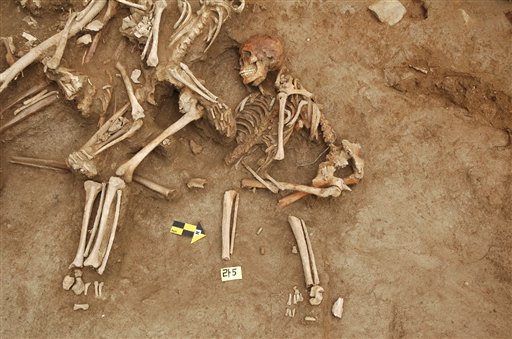
The exact number of people who have died in flood-ravaged Uttarakhand may never be known even as the state government put the number of missing at 3,000 with rescue operations entering the final phase.
“We will never know the exact number of those dead and the number of people who have been buried or washed away,” chief minister Vijay Bahuguna told news agency PTI in an interview.
As many as 900 stranded pilgrims and locals in Badrinath were left to be evacuated on Sunday as authorities grappled with the grim task of extricating dead bodies from under heaps of debris and performing the last rites.
Rains on Sunday prevented rescuers from reaching Kedarnath town to extricate bodies buried in the rubble even as the National Disaster Management said the death toll could be 'huge' as they gain access to areas ravaged by the flash flood a fortnight ago.
"National Disaster Relief Force team had planned to go to Kedarnath town with heavy equipment to extricate the bodies, but the heavy lift helicopters could not take off with the equipment due to bad weather," M Sashidhar Reddy, vice chairman of National Disaster Management Authority (NDMA), told reporters.
When asked about the death toll, Reddy said Uttarakhand Speaker had put the figure around 10,000, but right now it's not possible to give the exact numbers.
"I can only say that the manner in which the disaster occurred, it indicates huge number of deaths," he said.
The blame game over the June 15 and 16 rains escalated on Sunday with the meteorological department saying it had issued “timely” warnings of heavy rains and landslides but the state government claimed these were not “specific”.
The claims and counterclaims come amid questions whether the administration ignored the warnings and of the large-scale devastation in the hill state could have been averted.
Even after two weeks, the picture remains unclear, with estimates of number of dead varying from several hundreds to several thousands. Assembly speaker Govind Singh Kunjwal said on Saturday that the number of those killed could be more than 10,000 but the CM said the figure was incorrect. The search and rescue operation was likely to end in a day to two, he said. Compensation for the families of deceased who were not from Uttarakhand would be sent to the state governments after getting reports from them.
"If missing persons do not return in the next 30 days, the state government (concerned) will assume them dead and pay adequate compensation subject to the affidavit provided by the family members," Bahuguna said, adding 1,335 villages were still cut off from other parts of the state while power supply to almost 500 villages had not been restored.
Teams of rescuers have started returning. No pilgrims were now stranded in Gangotri, Yamnotri, Kedarnath and Hemkund Sahib, army sources said. A 200-member team comprising policemen, forensic experts, mountaineers, fire fighters and helpers will go to Kedarnath to pull out bodies from underneath the debris, officials said on Sunday.
Half the team will fly from the Guptkashi base station to reach the disaster zone by Monday afternoon. The rest will join them later. No cremation took take place on Sunday because of bad weather.
"The team's takeoff will depend on the weather," deputy inspector general of police Sanjay Gunjiyal told HT.
The exact number of people who have died in flood-ravaged Uttarakhand may never be known even as the state government put the number of missing at 3,000 with rescue operations entering the final phase.
Dearth of travel records impedes search, relief ops
Owing to the lack of records of Nepali pilgrims ’ entry to, and exit from, Uttarakhand, family members of the missing flood victims are going through hard times coping with the police and other government bodies in carrying out efficient search operations.
“Officials ask for the record of the entry of my parents to Uttarakhand, and their last traced location,” said Krishna Chalise, whose parents Kritinath and Jamuna, in pilgrimage to Uttarakhand, went missing in the flood. “But we don’t have any such documented report to submit. I don’t really know where they went missing from.”
Chalise’s parents have been missing for the last 13 days. According to him, he is preparing to go back to Kathmandu as all the search operations have turned futile.
Families of a dozen Nepali nationals who have gone missing in the flood are facing similar problems.
Pushpa Raj Pandey, manager of Anandamayee Aashram at Haridwar, has similar plight. According to him, Nepali nationals who come to visit Uttarakhand are not registered in any of the government agencies. “They don’t have passport, the citizenship certificate or any other document,” he said.
Many have pointed fingers at the open Nepal-India border behind the problems relating to the lack of proper accounts of those crossing the border.
“This has resulted in difficulties for the Nepali nationals not only in search operations but also in claiming relief packages from the Indian government,” said Narayan Panthi, a social worker based in Haridwar.
Raju Rana from Rukum district, who was admitted to the Dehradun-based Jolivent Hospital on Saturday, had similar hardship. “He was never registered with the government and no one really knows how long he has been here,” the hospital management said. Rana has sustained injuries in the spinal cord.
According to the Nepali Embassy in New Delhi, over 100 Nepalis have reported to the Embassy saying that their relatives had been missing. However, none of the reports is an authentic account of the missing person’s arrival in India.
“This has taught both the countries a lesson,” said Surya Bikram Shahi, chairman of the Gorkha Democratic Front in Dehradun. “Both the governments should keep records of every individual crossing the border. Open border does not necessarily mean unaccounted entries.”
Monday 1 July 2013
http://www.hindustantimes.com/India-news/NorthIndiaRainFury2013/Exact-count-of-dead-in-Uttarakhand-may-remain-unknown-Bahuguna/Article1-1084732.aspx
http://www.ekantipur.com/2013/06/30/top-story/nepalis-in-uttarakhand-floods-dearth-of-travel-records-impedes-search-relief-ops/374072.html






